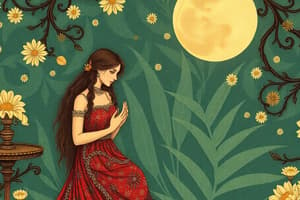Podcast
Questions and Answers
What pronoun is primarily used in first-person point of view narratives?
What pronoun is primarily used in first-person point of view narratives?
- You
- I (correct)
- He
- They
Which characteristic best describes third-person limited point of view?
Which characteristic best describes third-person limited point of view?
- The narrator expresses the thoughts and feelings of multiple characters simultaneously.
- The narrator can only describe actions without the mental state of characters.
- The narrator provides insights only into the thoughts of a single character. (correct)
- The narrator knows everything about all characters.
What does a biographical approach to analyzing a literary text focus on?
What does a biographical approach to analyzing a literary text focus on?
- The society's reaction to the text at the time of publication.
- The historical events surrounding the story.
- The author's life experiences and how they relate to the work. (correct)
- The literary techniques employed in the text.
What is the primary focus of analyzing the historical context in literature?
What is the primary focus of analyzing the historical context in literature?
In which point of view does the narrator refer to the reader as 'you'?
In which point of view does the narrator refer to the reader as 'you'?
What best describes the point of view in which the narrator knows the thoughts and feelings of all characters involved?
What best describes the point of view in which the narrator knows the thoughts and feelings of all characters involved?
How does a first-person narrative affect the reader's experience of the story?
How does a first-person narrative affect the reader's experience of the story?
Which of the following best defines historical context in literature?
Which of the following best defines historical context in literature?
What distinguishes third-person limited point of view from third-person omniscient?
What distinguishes third-person limited point of view from third-person omniscient?
In biographical literary analysis, what is typically examined?
In biographical literary analysis, what is typically examined?
Flashcards
Main Idea of a Story
Main Idea of a Story
The central message or topic of a story.
Inciting Incident
Inciting Incident
The event that initiates the conflict in a story.
Internal Conflict
Internal Conflict
A struggle within a character's mind.
External Conflict
External Conflict
Signup and view all the flashcards
Conflict in a Story
Conflict in a Story
Signup and view all the flashcards
First-person POV
First-person POV
Signup and view all the flashcards
Third-person limited POV
Third-person limited POV
Signup and view all the flashcards
Third-person omniscient POV
Third-person omniscient POV
Signup and view all the flashcards
Biographical approach to literature
Biographical approach to literature
Signup and view all the flashcards
Historical approach to literature
Historical approach to literature
Signup and view all the flashcards
Study Notes
Literature - Short Stories
- Short stories are a type of fiction.
- They have a limited number of characters, a restricted setting, and a narrow range of action.
- They can be read in a single sitting.
- Key elements include plot, setting, characters, characterization, conflict, point of view (POV), and other narrative techniques.
- Structural analysis focuses on the literary elements within the story, not the author's life or historical context.
- These elements work together to create a unique short story.
Plot
- Plot is the arrangement of events and actions in a story.
- It's the framework of the story.
- It details every aspect of the characters' experiences.
Characters
- A character is a person or animal in a story.
- Characters are introduced in the exposition.
- Characters' actions and experiences reveal their traits and development.
- Characters can be dynamic (round), changing throughout the story, or flat (static), remaining unchanged.
- Stock or stereotype characters are simple characters with common traits.
- Protagonist: The main or leading character.
- Antagonist: The character who opposes or conflicts with the main character.
Characterization
- Characterisation is how an author reveals personality.
- Direct characterization: The author directly states character traits.
- Indirect characterization: The author shows character traits through actions, speech, thoughts and interactions.
Conflict
- Conflict is the problems or struggles within a short story, usually resolved by the end.
- Internal conflict: Character vs. self
- External conflict: Character vs. character, society, nature, supernatural, or technology.
Point of View (POV)
- POV is the perspective from which a story is told.
- First-person: Uses the pronoun "I" or "we."
- Second-person: Uses the pronoun "you."
- Third-person limited: Narrator tells story from one character's perspective.
- Third-person omniscient: Narrator knows and describes all characters' thoughts and feelings.
Theme
- Theme is the central idea conveyed, often implicit.
- Themes are often connected to human or social experiences, cultural, or personal experiences.
Historical and Biographical Context
- The biographical context of a text relates the events to the author's experiences.
- The historical context relates the events to the social, cultural, and political climate of the time period in which the events unfold.
- Understanding the time period and author's life adds another layer of meaning to a piece of writing.
Sociocultural Context
- Analyzing a literary text in a sociocultural context involves understanding the sociocultural practices and beliefs of the culture and period in which it was written.
- Theme, local color, and sociocultural values can be identified within a text to further understand the context.
Revising and Editing
- Revising: Evaluating writing content
- Editing: Checking for grammar, spelling, and punctuation errors.
- Publishing: Sharing written work
- Using transition markers strengthens the flow of writing.
Studying That Suits You
Use AI to generate personalized quizzes and flashcards to suit your learning preferences.




